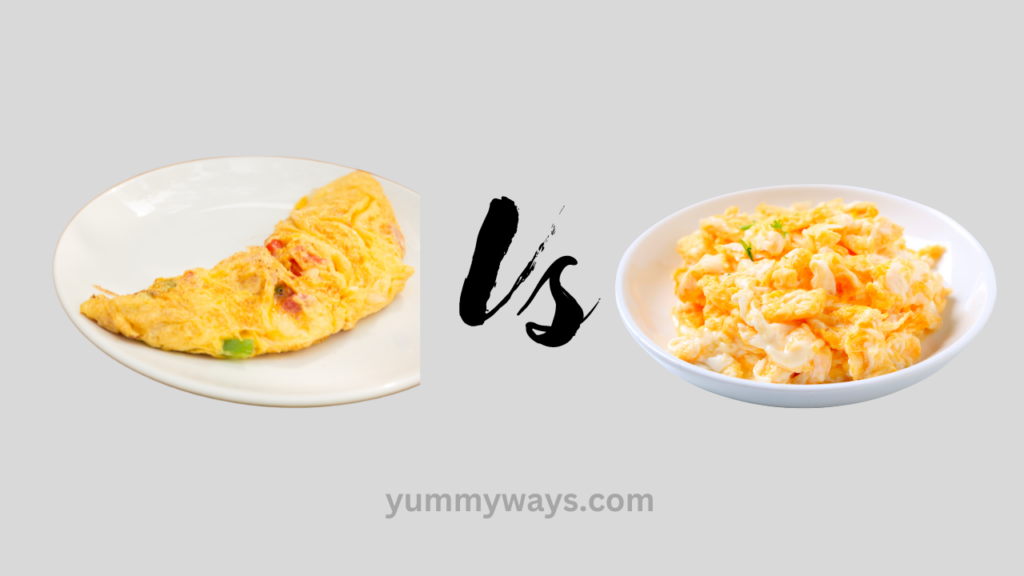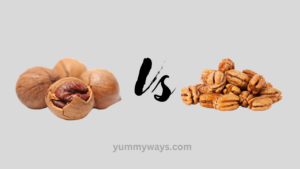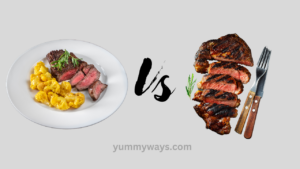Omelette and scrambled eggs are both popular breakfast options offering unique textures and flavors. Breakfast is often considered the most important meal of the day, and for many, it’s a chance to indulge in delicious and satisfying dishes.
Two such breakfast options that are beloved by many are omelettes and scrambled eggs. Both dishes are made with eggs as a base, but they offer different textures and flavors. Omelettes are traditionally folded over a filling such as vegetables, cheese, or ham, resulting in a fluffy and cohesive dish.
On the other hand, scrambled eggs are lightly cooked and constantly stirred, resulting in soft and creamy curds. Whether you prefer the elegance of an omelette or the comforting simplicity of scrambled eggs, both options are versatile and delicious.
Contents
Overview Of Omelette Vs Scrambled Eggs

Also Read: Japanese Bbq vs Korean Bbq: What’s the Difference?
Omelette
An omelette is a versatile and delicious dish that has been enjoyed for centuries. Offering a perfect blend of fluffy eggs and a variety of fillings, this dish is popular for breakfast, brunch, or even a quick dinner. Let’s explore the omelette, its definition, origin, popular variations, and recipe tips to help you perfect this classic dish.
Definition And Origin
An omelette is a simple and classic dish made from beaten eggs cooked with fillings such as cheese, vegetables, or meats. This dish originated in Ancient Persia and quickly spread throughout the Mediterranean region, evolving into various regional versions.
Popular Variations
There are countless variations of omelettes around the world. Some of the most popular include:
- French Omelette: A delicate, lightly cooked omelette with a creamy interior.
- Spanish Omelette (Tortilla Española): A thick omelette with potatoes and onions, often enjoyed as a tapa.
- Vegetarian Omelette: Filled with an array of fresh vegetables, perfect for a healthy meal.
- Western Omelette: Typically filled with diced ham, bell peppers, and onions.
Recipe Tips
To create a perfect omelette, keep these tips in mind:
- Use a non-stick pan to prevent sticking and make flipping easier.
- Prep your fillings ahead of time to ensure everything is ready for assembly.
- Do not overbeat the eggs; a gentle mix will result in a fluffier omelette.
- Cook over low to medium heat to avoid browning the eggs.
Scrambled Eggs
Discover the distinction between omelettes and scrambled eggs. While omelettes are folded with fillings, scrambled eggs are gently stirred as they cook, resulting in a fluffy and creamy texture. Both are versatile and can be customized with various ingredients.
Scrambled eggs are a classic breakfast dish that is loved by many for its simplicity and deliciousness. This versatile dish can be enjoyed on its own or paired with a variety of ingredients to create a tasty and nutritious meal. In this section, we will explore the simple yet delicious cooking techniques for making scrambled eggs and creative additions that can take this dish to the next level.
Simple Yet Delicious
Making scrambled eggs is incredibly easy and requires just a few basic ingredients. To start, crack 2-3 eggs into a bowl and whisk them until they are well beaten. Heat a non-stick pan over medium-low heat and add a knob of butter. Once the butter has melted, pour in the beaten eggs and let them cook for a few seconds.
Tip: Whisking the eggs thoroughly before cooking will ensure that they are light and fluffy.
To achieve those soft curds that we all love in scrambled eggs, gently push the cooked eggs from the edges towards the center using a spatula. Continue doing this until the eggs are mostly cooked, but still slightly runny. Remove the pan from heat as the residual heat will continue to cook the eggs to perfection.
Also Read: Teppan vs Hibachi: Which will reign supreme in your taste buds?
Cooking Techniques
There are a few key cooking techniques that can elevate your scrambled eggs from ordinary to extraordinary. One popular method is to add a splash of milk or cream to the beaten eggs before cooking. This helps to make the eggs even creamier and adds a subtle richness to the dish.
Another technique is to cook the scrambled eggs low and slow. This means using a low heat setting and cooking the eggs slowly to achieve a luscious texture. Patience is key with this method, as it may take a bit longer to cook, but the end result will be worth it.
Pro tip: For an extra indulgent twist, you can add a sprinkle of grated cheese or a dollop of crème fraîche to your scrambled eggs just before they finish cooking. The cheese will melt and create a gooey, savory coating, while the crème fraîche will add a tangy creaminess.
Creative Additions
While scrambled eggs are delicious on their own, they can also be easily customized with an array of creative additions. Here are a few ideas to get you started:
- Chopped vegetables such as bell peppers, onions, and mushrooms can add color, flavor, and texture to your scrambled eggs.
- Herbs like chives, parsley, or dill can provide a burst of freshness and a vibrant taste.
- For a protein-packed twist, you can add diced cooked bacon, ham, or smoked salmon to the eggs.
- If you’re a fan of spicy flavors, try mixing in a pinch of cayenne pepper or some hot sauce.
With these creative additions, you can turn a simple plate of scrambled eggs into a gourmet breakfast or brunch dish that will impress your friends and family.
Remember, scrambled eggs are a versatile dish that can be enjoyed at any time of the day. Whether you prefer them plain and simple or packed with flavorful additions, mastering the art of making scrambled eggs will make you the breakfast hero in no time.
Nutritional Value
Omelettes and scrambled eggs offer similar nutritional value, packed with protein and essential vitamins. While omelettes include additional ingredients like vegetables and cheese, scrambled eggs are simple and quick to prepare. Both options provide a wholesome and satisfying breakfast choice.
Protein Content
When it comes to nutrition, both omelettes and scrambled eggs are excellent sources of protein. Protein plays a vital role in building and repairing tissues, supporting muscle growth, and boosting satiety. However, the protein content may vary depending on how the eggs are prepared.
An omelette typically contains around 6 grams of protein per large egg. The protein in an omelette is derived from both the egg white and the yolk, as both parts are used in its preparation. This makes omelettes a well-rounded source of amino acids, which are the building blocks of protein.
On the other hand, scrambled eggs tend to have slightly less protein content, with around 5 grams of protein per large egg. This is because scrambled eggs are usually made by mixing only the egg whites or a combination of both whites and yolks. While the egg whites provide most of the protein, the exclusion of the yolk reduces the overall protein content.
Vitamins And Minerals
In terms of vitamins and minerals, both omelettes and scrambled eggs offer a range of essential nutrients necessary for overall health and well-being.
Omelettes contain a higher concentration of vitamins and minerals compared to scrambled eggs. This is because omelettes utilize both the egg white and yolk, which carry different nutrients.
For instance, the yolk contains essential fat-soluble vitamins such as vitamin A, vitamin E, vitamin D, and vitamin K. It also provides minerals like iron, phosphorus, selenium, and zinc.
Scrambled eggs, on the other hand, are typically made with only the egg whites or a combination of both whites and yolks. While the egg whites are a great source of protein, they lack the same level of vitamins and minerals found in the yolk. This means that scrambled eggs may not offer the same nutritional variety as omelettes.
Comparative Analysis
In summary, omelettes and scrambled eggs offer similar nutritional value in terms of protein content. However, omelettes provide a greater variety of vitamins and minerals due to the inclusion of the egg yolk.
| Omelette | Scrambled Eggs | |
|---|---|---|
| Protein Content | 6 grams per large egg | 5 grams per large egg |
| Vitamins and Minerals | Includes essential vitamins and minerals from both egg whites and yolk. | May lack the wide range of vitamins and minerals found in the yolks. |
Ultimately, the choice between omelettes and scrambled eggs depends on individual preferences and dietary needs. Both options can contribute to a well-balanced and nutritious meal, providing a good source of protein and various vitamins and minerals.
Taste And Texture
Omelette and scrambled eggs both offer unique taste and texture experiences. While omelettes are typically fluffy and filled with various ingredients, scrambled eggs are light and airy with a creamy texture. Enjoy a flavorful omelette or a simple yet satisfying plate of scrambled eggs for a delightful breakfast choice.
Taste and texture play a pivotal role in defining the culinary experiences of different egg dishes. The contrast between an omelette and scrambled eggs in terms of taste and texture is a matter of personal preference, with each offering a unique sensory delight.
Omelette Characteristics
An omelette, a classic French dish, is renowned for its fluffy texture and creamy center. The eggs are beaten and cooked at a controlled temperature, resulting in a delicate and smooth mouthfeel. The outer layer often retains a slight firmness, offering a satisfying contrast to the silken interior.
Scrambled Eggs Traits
Scrambled eggs, on the other hand, boast a rich and moist consistency. The eggs are vigorously stirred during cooking, yielding small, tender curds. The result is a dish with a luscious, soft texture, with variations from creamy to custard-like, depending on the desired level of doneness.
Preference Polls
When asked to choose between the two, people often lean towards the omelette for its fluffiness and creamy center, while others appreciate the buttery richness and soft texture of scrambled eggs. Ultimately, the preference for taste and texture is a matter of individual fondness for either the silky and smooth nature of an omelette or the moist, creamy allure of scrambled eggs.
Culinary Uses
Culinary Uses: Omelette and scrambled eggs are versatile options that can be incorporated into various dishes across different cuisines.
Breakfast Delicacy
Omelettes are known as a popular breakfast choice, while scrambled eggs offer a comforting start to the day.
- Ingredients: Both – eggs
- Preparation: Omelette – beaten eggs cooked flat; Scrambled – eggs stirred in the pan.
- Seasoning: Various spices can be added to enhance flavor.
Main Course Inclusions
Versatile dishes like egg fried rice, frittatas, and egg wraps benefit from omelettes or scrambled eggs.
- Proteins: Adds nutritious protein source to the meal.
- Fillings: Vegetables, cheese, and meats can be mixed with the eggs.
- Side dish: Serve with toast or salad for a balanced meal.
International Adaptations
In various cultures, eggs are utilized differently, from French omelettes to Indian spiced scrambled eggs.
- Mexico: Huevos rancheros with scrambled eggs.
- Italy: Frittata di pasta with leftover pasta and eggs.
- Japan: Tamagoyaki, a rolled omelette sweetened with sugar and soy sauce.
Health Considerations
Omelette Vs Scrambled Eggs: Understanding the health implications of these popular breakfast options is essential for making informed choices.
Calorie Comparison
Evaluating the calorie content reveals that omelettes often contain fewer calories than scrambled eggs.
Cholesterol Levels
Omelettes: Typically prepared with whole eggs, omelettes can be higher in cholesterol compared to scrambled eggs.
Dietary Recommendations
- Choose: Omelettes with more vegetables for added nutrients.
- Avoid: Adding excessive cheese or fatty meats to either dish.
Conclusion
Both omelette and scrambled eggs have their unique appeal. Whether you prefer the fluffy texture of omelette or the creamy consistency of scrambled eggs, both dishes offer a delicious and versatile way to enjoy eggs. Ultimately, the choice between the two comes down to personal preference and the desired cooking method.

